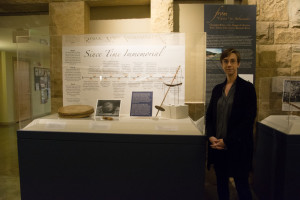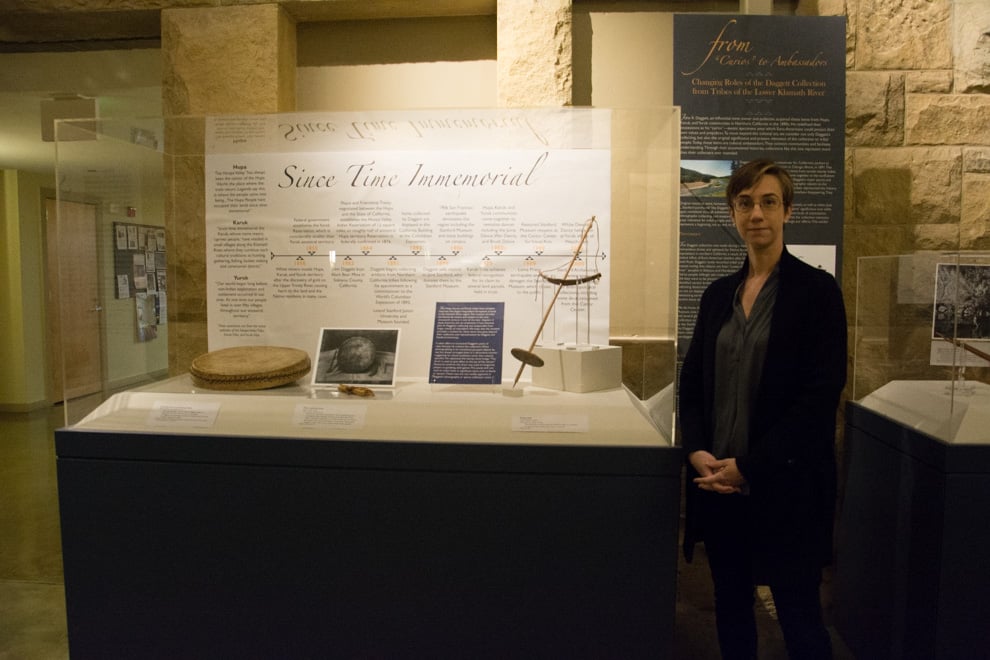
The Stanford Archaeology Center is currently home to a student-produced exhibit that explores Native American culture specific to Northern California. The exhibit first opened to the public on June 4, 2015 and will remain on display throughout this academic year.
Titled “From Curios to Ambassadors: Changing Roles of the Daggett Collection from Tribes of the Lower Klamath River,” the exhibit was the product of ARCHLGY 134: “Museum Cultures: Material Representation in the Past and Present.” The class, led by Christina Hodge, academic curator and collections manager for the Stanford Archaeology Collections, worked on the exhibit during spring quarter 2015.
Students who took Hodge’s class had the opportunity to curate items collected by John R. Daggett, an entrepreneurial miner in the late 1800s, who developed a fascination for collecting items from the Native American tribes that lived near his mines.
During his lifetime, Daggett accumulated a repository of articles from Native American life, even displaying them at the 1893 World’s Fair. The collection that Jane Stanford eventually purchased for the Leland Stanford Jr. Museum in 1899 represented Daggett’s narrow perspective of Northern Californian tribal life, Hodge explained. A century later, Stanford’s Cantor Arts Center opened its archives to the Archaeology Center, and Hodge’s class last spring became an opportunity to display the pieces in a new light.
Students worked together to learn about the tribes represented in the collection by studying their culture and aesthetics. From writing labels and fashioning object stands to making informed decisions about what pieces to show, the students shared responsibility for curating the exhibit.
The Archaeology Center also partnered closely with the Native American Cultural Center to put together the exhibit. Guest speakers and presenters educated students on Native American laws and civil rights. Tribal representatives from the Hupa Valley and Yurok tribes, indigenous to Northern California, visited the class and provided context for the pieces. Students learned that certain ceremonial items in the collection, for example, held sacred religious value, and out of respect for these traditions, these items were consequently omitted from the exhibit.
“For projects like this one, you need to recognize that there are other folks who have information and perspectives on these items that might be different than yours,” Hodge said. “And you really need to honor those when you’re working on these items.”
Students also visited Cantor’s Native American Art Gallery to examine different ways of showcasing cultures.
“You have to keep into consideration we’re exhibiting people that are alive today,” said Isabella Robbins ’17, a student in the class who is also part of Stanford’s Native American community.
Robbins explained the role of aesthetics in exhibit design: From lighting choices to the angles at which objects are placed, each decision reflects on the gallery’s attitude toward its subjects.
However, according to Robbins, the exhibit’s aesthetic was not a primary concern.
“This wasn’t so much about the objects as aesthetic, valuable items,” Robbins said. “It was more about highlighting the information and the tribal voices as best we could. Museum spaces are very colonized spaces so a goal for me was to decolonize the pieces as much as I could.”
The exhibit’s title provides insight into the guiding philosophy behind its conception, explained Hodge.
“For Daggett, these objects were curious; they were strange; they were exotic; they were about a disappearing indigenous way of life,” Hodge said.
Over 100 years since Daggett first collected these items, Hodge now views them instead as representatives of culture.
“They are ambassadors from their home communities — here to represent their cultures, here to educate about them, here to make connections between communities,” she added.
The exhibit will be on display at the Archaeology Center until June 1, 2016.
Contact Namita Nabar at nnabar ‘at’ stanford.edu.
